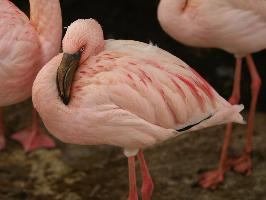
Cunoscut și ca
- Plameňák růžový starosvětský
Greutăți și măsuri
| Înălțime la greabăn | de la 120 la 140 cm |
|---|---|
| Greutate | de la 2,1 la 4,1 kg |
| Lungimea anvergurii aripilor | de la 140 la 170 cm |
Descrierea animalului
The Greater Flamingo (Phoenicopterus roseus) is a striking and easily recognizable bird, renowned for its long, lean legs, distinctive pink to reddish plumage, and unique feeding habits. As the most widespread species of the flamingo family, it inhabits the edges of lakes, lagoons, estuaries, and shallow coastal areas in parts of Africa, southern Asia (including the Middle East), and southern Europe.An adult Greater Flamingo stands impressively tall, reaching heights of up to 150 cm (59 inches), making it the largest species of flamingo. Its wingspan is equally impressive, extending up to 140-165 cm (55-65 inches). The bird's plumage is predominantly pink, ranging from a pale and delicate hue to a more vibrant and deeper shade, depending on the bird's diet. The feathers on the wings are brighter and more vivid, with black flight feathers that are most visible during flight.
One of the most distinctive features of the Greater Flamingo is its long, curved neck and equally long legs, which allow it to wade into deeper waters than most other birds to find food. Its large, downward-curving bill is specially adapted for its unique feeding technique. The bill is equipped with a sophisticated filtering system that enables the bird to sift through mud and water to capture small organisms such as shrimp, algae, and other invertebrates. This diet is rich in carotenoids, which are responsible for the bird's pink plumage. The intensity of the coloration is directly related to the concentration of these pigments in their diet.
Greater Flamingos are highly social birds, living in large colonies that can number in the thousands. These colonies offer protection against predators and increase the efficiency of finding food. The breeding season brings an elaborate display of synchronized dances, head-flagging, and loud calls as part of their courtship rituals. They build their nests out of mud, creating cone-shaped mounds with a top depression where the eggs are laid. Typically, a single chalky-white egg is laid, which both parents incubate.
The chicks are born with a white downy plumage and a straight bill, which begins to curve as they grow older. Initially, the young are fed a nutritious substance known as "crop milk," produced by both parents. It takes several years for the juveniles to achieve the full pink coloration of their plumage, gradually transitioning from a dull gray as their diet begins to include more carotenoid-rich foods.
Conservation efforts for the Greater Flamingo focus on protecting their habitats from pollution, disturbance, and development. While the species is currently not considered endangered, it faces threats from habitat loss and degradation, particularly in regions where wetlands are drained for agriculture or urban development. International cooperation has led to the establishment of protected areas and conservation programs aimed at ensuring the survival of this remarkable species.
In summary, the Greater Flamingo is an iconic bird that captivates observers with its beauty, complex behavior, and fascinating feeding habits. Its presence in wetlands across a broad geographic range highlights the importance of these ecosystems not just for flamingos but for a myriad of other species that depend on these habitats for survival.
Animale similare
Fotografii noi cu animale
Top 10 animale
- Dolphin gull (Leucophaeus scoresbii)
- Diana monkey (Cercopithecus diana)
- Moustached guenon (Cercopithecus cephus)
- Galápagos tortoise (Geochelone nigra complex)
- Stone loach (Barbatula barbatula)
- Japanese macaque (Macaca fuscata)
- Greek tortoise (Testudo graeca)
- Russian tortoise (Testudo horsfieldii)
- Common flying dragon (Draco volans)
- Galápagos penguin (Spheniscus mendiculus)
